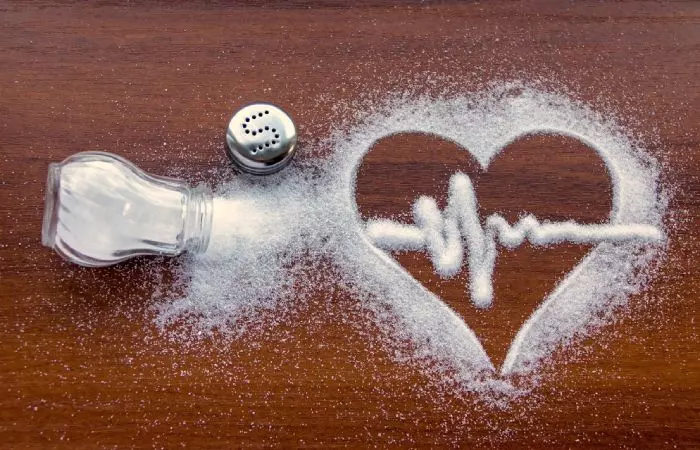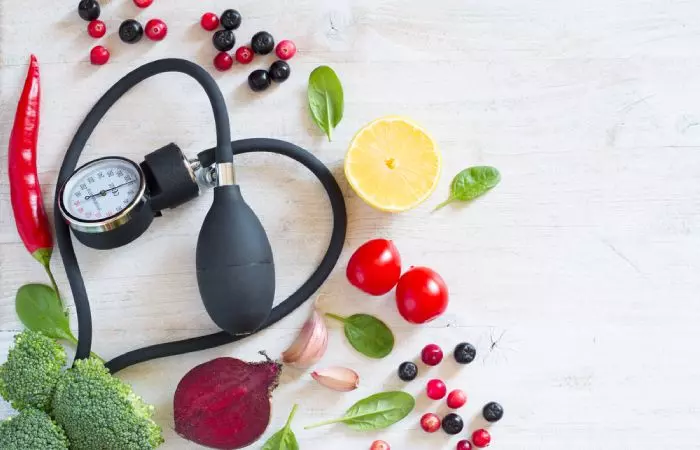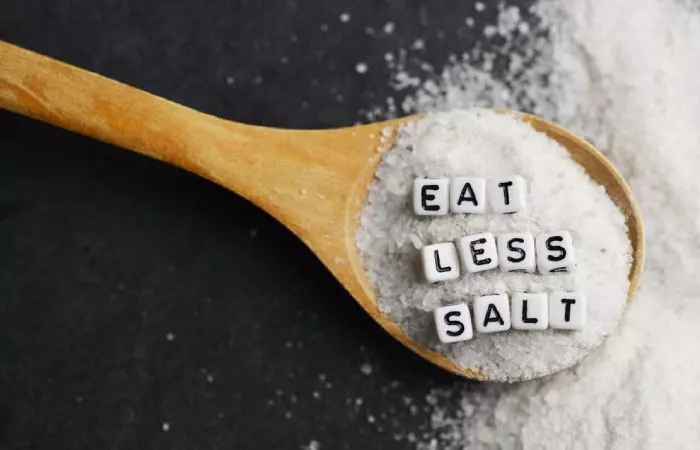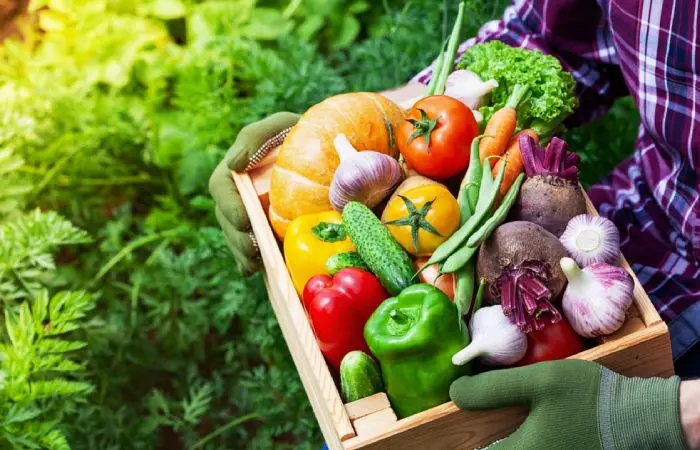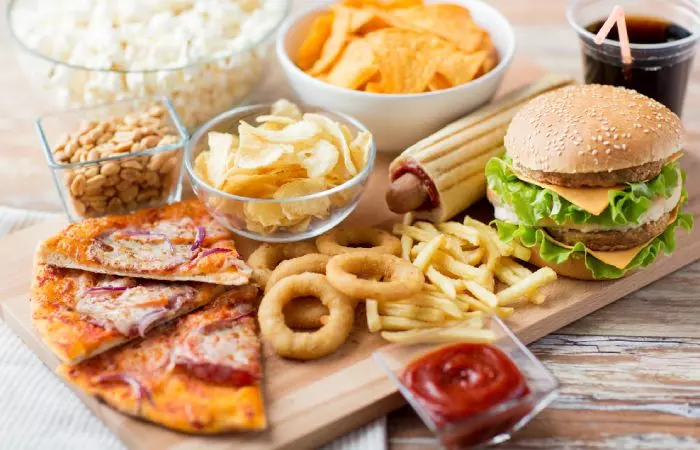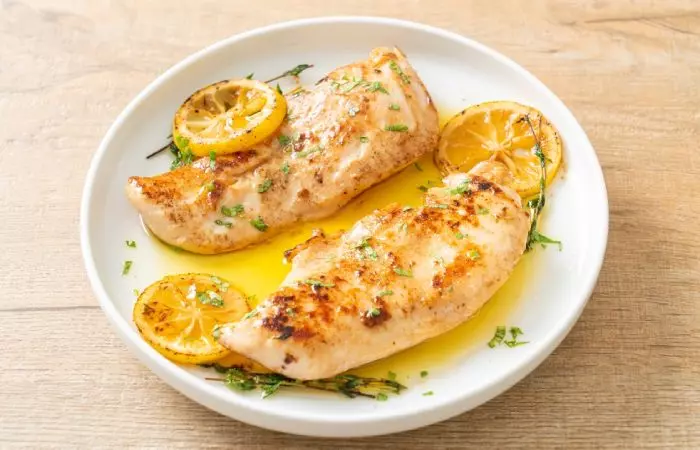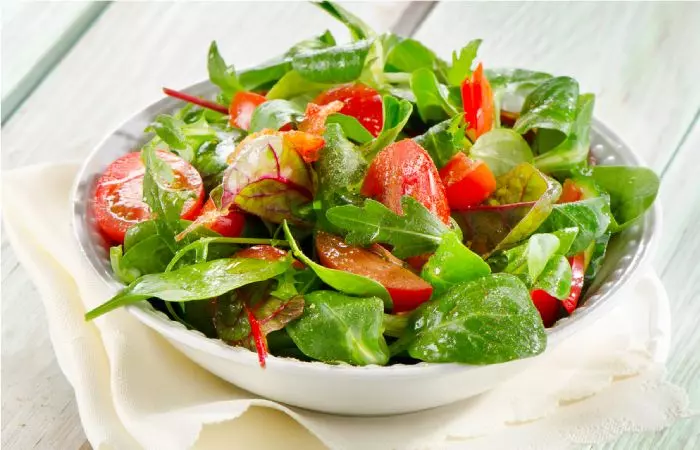Consuming a low-sodium diet helps manage high sodium levels. This article explores the details of a low-sodium diet, healthy low-sodium diet foods, and a balanced meal plan that you may follow. Scroll down to learn more.
What Is A Low-Sodium Diet?
A low-sodium diet involves consuming foods that keep your sodium intake under the recommended dose. It may help reduce the risk of cardiovascular diseases such as hypertension. The acceptable dose of sodium for a healthy individual is between 3-5 grams/day. Your chances of developing cardiovascular diseases increase if your sodium intake is higher or lower than this recommended range (3). However, a low-sodium diet may be recommended to manage elevated sodium levels. Since sodium is found in a lot of food other than just salt, a low-sodium diet involves the customization of meals. It helps maintain the required levels of sodium levels in your body.
How Much Sodium Is In A Low-Sodium Diet?
Even If you are healthy, you need to watch your sodium intake. According to a study based on prospective cohort evidence, the general population should aim for <5 g sodium per day (3). For people with conditions like hypertension, obesity, chronic kidney disease, or diabetes, 1.5-2.3 grams (1,500-2,300 mg) per day is recommended (4). This limit is considered ideal by the American Heart Association as well (5). A low-sodium diet plan helps manage blood pressure, which is necessary in effective diets for good heart health, like the low-cholesterol diet. However, the debate over the adequate recommended range of sodium is still ongoing among the leading health organizations (5). Therefore, consult a healthcare expert for personalized recommendations. The doctor may advise you to lower your sodium intake due to various health reasons. The next section explores why you should consider limiting your dietary sodium.
Why Should You Reduce Sodium In Your Diet?
Many people consume way more sodium than their bodies need. While a little sodium is necessary for good health, having too much can lead to health issues. The major reason is that sodium impacts how your body manages fluids. Consuming too much salt increases fluid retention that may raise your blood pressure (5). You need to reduce your sodium intake as a high-sodium diet may lead to (6), (7):
Hypertension Osteoporosisi A medical condition characterized by weak and brittle bones, making them more susceptible to fractures. Stomach cancer Diabetes Kidney diseases Neurological problems Cardiovascular diseasesi A class of diseases that involve the heart and blood vessels, including conditions like heart disease and stroke. Vasculaturei Refers to the network of blood vessels in the body, including arteries, veins, and capillaries. damage Stroke
A low-sodium diet will gradually help you alleviate the symptoms of this disorder and improve your overall well-being. Check out the next section to learn the ways a low-sodium diet benefits your health.
Health Benefits Of A Low-Sodium Diet
Regulates Blood Pressure
Research shows that excessive intake of ultra-processed foods that are high in sodium increases the risk of high blood pressure (9). Excess sodium may lead to increased fluid retention that may cause higher pressure in the blood vessels. Reducing sodium intake may help lower blood pressure and be beneficial for hypertension (4).
Improves Heart Health
This type of diet may reduce the risk of heart disease by improving blood vessel function and reducing any strain on the heart. It may also lower the risk of congestive heart failure, a condition in which the heart is unable to pump blood effectively (5). The DASH diet is one such diet designed to reduce sodium intake to manage high blood pressure and improve overall heart health.
Improves Kidney Health
Less sodium can be beneficial for individuals with kidney problems, as it may help reduce the workload on the kidneys. It may also slow the progression of kidney disease and reduce the risk of kidney stones (10), (11).
May Reduce Edema
It may alleviate swelling caused by excess fluid retention in the body. This is important for individuals with conditions like heart failure, liver disease, or kidney disease (12).
Lowers The Risk of Stomach Cancer
Research suggests that a low-sodium diet may be associated with a reduced risk of stomach cancer as compared to a high-sodium diet (13).
Builds Stronger Bones
Research shows that high sodium intake negatively affects bone health (14). Lower sodium levels may help prevent excessive urinary calcium excretion, promoting better bone density and overall bone health. Make sure to strike a balance between sodium reduction as too little or too much of it can be equally worse.
May Help Manage Diabetes
A low-sodium diet may be beneficial for individuals with diabetes as it may help in managing blood pressure. It is shown to improve HbA1c levels and fasting blood glucose that may manage diabetes and improve overall cardiovascular health (15).
May Improve Diet Quality
A low-sodium diet may encourage you to reduce the intake of processed and unhealthy foods, leading to better overall nutrition. With the aim of sodium reduction, you start consuming fresh and whole foods that can promote better health. This may help lower the risk of hypertension and related health issues. There is no doubt that reducing sodium can be beneficial for your health. Keep reading to know how to transition to a low-sodium diet.
General Guidelines For Cutting Down On Sodium Intake
Sodium is not just found in salt. Ultra-processed foods are the main source of dietary sodium (2). Therefore, a low-sodium diet is essentially a diet that minimizes ultra-processed foods and emphasizes choosing minimally processed whole foods. Many benefits of a low-sodium diet may not actually come from reducing sodium intake but could be due to improving overall diet quality. Follow the below low-sodium diet guidelines issued by the FDA (16), (17):
Pay close attention to food labels and the nutrition facts panel to check the sodium content per serving. Choose fresh foods like fruits, vegetables, lean meats, and whole grains as they are lower in sodium compared to processed and pre-packaged foods Cook your meals at home to have control over the ingredients you use. Use herbs and spices instead of salt to flavor your dishes. Be cautious with condiments such as ketchup, salad dressings, and soy sauce as they may be high in sodium. Rinse and drain canned beans, tuna, and cottage cheese to help reduce their sodium content. Practice portion control even if a food is low in sodium per serving. Focus on gradual reduction if you are used to a high-sodium diet. Educate yourself about the salt content of common foods to select your foods carefully.
It is also essential to know about your required sodium intake to figure out your meals on a low-sodium diet. Scroll down to the next section to get an idea about your average sodium needs per day.
How To Plan A Low-Sodium Diet
Before starting a low-sodium diet, you should determine your daily sodium requirement, which may differ based on your age and conditions. The National Academies of Sciences, Engineering and Medicine establishes the recommended sodium dose as per age and health as suggested in the following table (18). Different foods have varying sodium levels that may lead to an overdose if not planned carefully. Read more to know about the foods you can eat on this diet.
A Low Sodium Foods List To Follow
The amount of sodium in foods keeps varying and depends on their source and how processed they are. Foods like fruits, vegetables, oils, and cereals are naturally low in sodium, typically containing anywhere from a tiny amount to around 20 mg per 100 g, except for a few exceptions such as bell peppers, broccoli, etc (1), (19). You can refer to the following list of low-sodium foods that some patients recommended in a study (20), (21), (22), (23). While these foods are great for a low-sodium diet, it is also important to know about some foods that you should avoid in this diet. Take a look at them down below.
List Of High-Sodium Foods To Limit Or Avoid
You must be able to identify foods high in sodium in order to avoid them to support cardiovascular health. Avoid the following foods on a low-sodium diet (19), (24), (25), (26), (27). Customizing your meal plan is the best way to avoid overdosing on high-sodium foods. It also helps keep your food options sorted. View the 7-day meal plan below for low-sodium breakfast, lunch, snack, and dinner ideas.
7-Day Low-Sodium Diet Meal Plan
Dieting can be tricky and may make you crave unhealthy options no matter how hard you try to avoid them. You can make your low-sodium diet interesting yet up to the guidelines. Learn about it in the following section.
Tips To Incorporate Low-Sodium Foods Into Meals And Snacks
According to FDA guidelines, if a food serving has 5% or less of the daily value for sodium, which is less than 2.3 mg, it is considered low-sodium. If the serving has 20% or more, then it’s high-sodium (16). Keep this in mind when picking what food to eat. Some additional tips are mentioned below (25):
When choosing canned products, look for “low-sodium” options. Eat tuna and salmon that are packed in water instead of oil. Use wines and vinegar as a substitute for salt to enhance flavors. You can have a total of up to 1/8th of a teaspoon of salt in your meals and snacks. Use potassium salt substitutes instead of sodium. When picking high-sodium foods, balance them with very low-sodium foods for the rest of the meals Avoid placing the salt shaker/container on the dining table.
Now it is time for some lip-smacking recipes that you can prepare easily. Scroll down to explore more.
Easy Low-Sodium Recipes
1. Grilled Lemon Herb Chicken
Ingredients
2 boneless, skinless chicken breasts 2 tablespoons of olive oil 2 cloves of garlic (minced) 1 lemon (juiced and zested) 1 teaspoon of dried thyme 1 teaspoon of dried rosemary Salt-free seasoning blend (to taste) Freshly ground black pepper (to taste)
How To Prepare
2. Tomato Basil Salad
Ingredients
4 ripe tomatoes (diced) 1/2 cup fresh basil leaves (chopped) 2 tablespoons of extra-virgin olive oil 1 tablespoon of balsamic vinegar (low-sodium) Salt-free seasoning blend (to taste) Freshly ground black pepper (to taste)
How To Prepare The amazing benefits of a low-sodium diet may make you want to cut out all salt from your meal. But wait a minute. Too much (or too little) of anything can be bad for your health, especially when it comes to diet. See how the strict limitation of sodium can be bad for your health.
Potential Risks Of A Low-Sodium Diet
Extremely low intake of sodium may interfere with the body’s natural function but consuming it excessively does no good either (2). Low sodium levels in the body can lead to the following health concerns (28):
ConfusionConvulsions Irritability Fatigue Muscle weakness Headache Restlessness Loss of appetite Vomiting Cramps Nausea
How can I find low-sodium foods in grocery stores? You can look for “low-sodium” labels on packaged foods and check nutrition labels for sodium content. Foods with 5% or less of the Daily Value (DV) for sodium are considered low-sodium. Can you eat rice on a low-sodium diet? Yes, you can eat rice on a low-sodium diet as it contains only 1 mg of sodium per 100 grams (29). How can I check my sodium level at home? You can only check your sodium levels through a blood test. However, you may look for symptoms such as nausea, high blood pressure, vomiting, swelling, etc., that may indicate high potassium levels. How do you maintain flavor in meals while reducing sodium content? Enhance flavor with herbs, spices, citrus, and vinegar instead of salt. Is it necessary to eliminate all salt from the diet when following a low-sodium plan? It’s not necessary to eliminate all salt, but use it sparingly. You can have 1/8th of a teaspoon of salt in a day. Are there cooking techniques that can enhance taste without adding sodium? Cooking techniques like roasting, grilling, and using aromatic ingredients can add flavor without extra sodium. Can a low-sodium diet lead to weight loss or weight management? A low-sodium diet may aid weight management by reducing overall ultra-processed foods in the diet. Following a low-sodium diet is associated with making overall more conscious food choices, which can lead to reduced caloric intake. Over a period of time, it may improve cardiovascular health and weight but using a low-sodium diet alone is not linked to weight loss (30). Sodium is not just found in salt. It can sneak inside your body through fast foods, packed foods, high-sodium condiments, etc. This is why you need to pay special attention to your diet. Watch the following video to learn the way to reduce your sodium intake.
